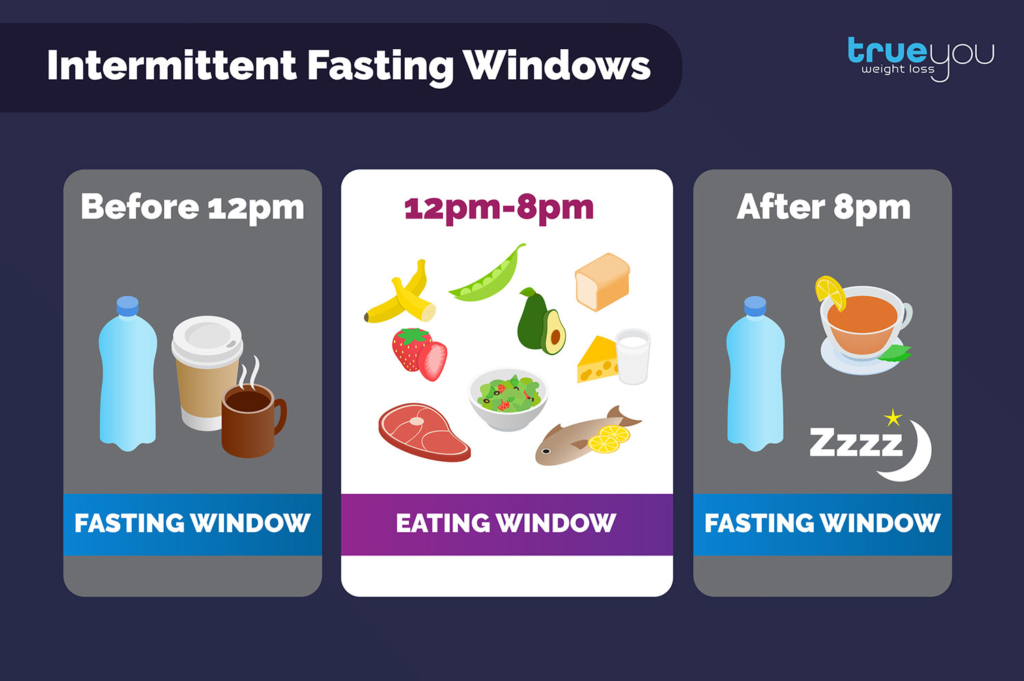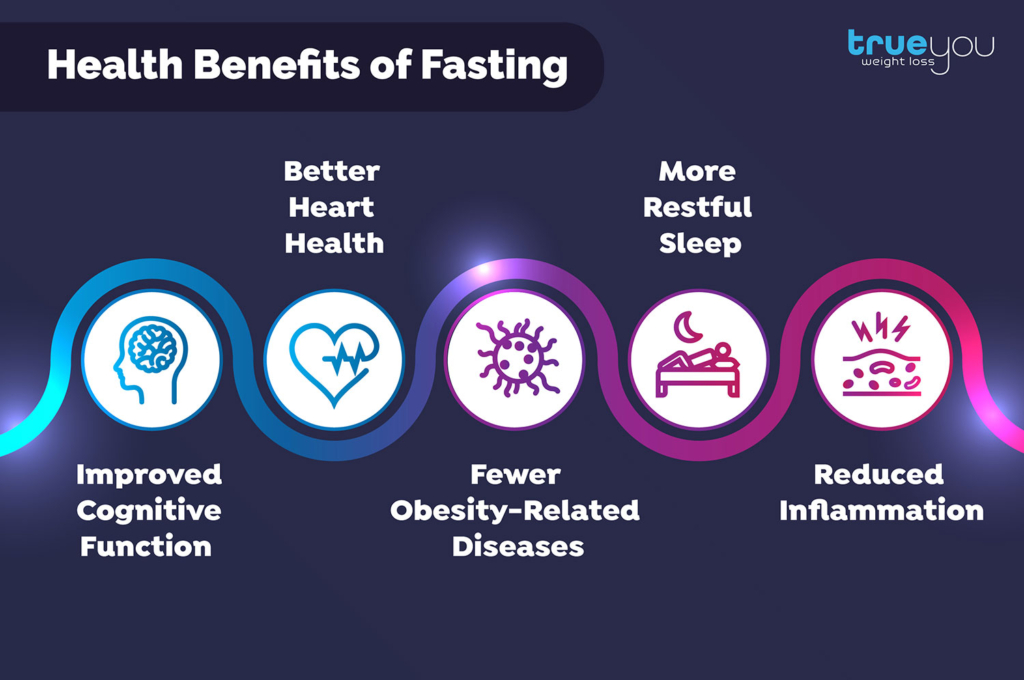Origins of IF | How Does IF Work? | Types of IF | Who Should Not Try IF | How Does IF Help | Health Benefits of IF | Experts Say | Pros and Cons of IF | IF Considerations | IF For Weight Loss? | Alternative Approaches
Over the past few decades, a pair of seemingly paradoxical trends have emerged: the number of people who are overweight or obese has risen at the same time as the number of people trying to lose weight. According to the Centers for Disease Control and Prevention, the decade from 2007-2017 saw obesity rates in the United States rise from 34% to 42% of the population. During the same period of time, the number of people attempting to lose weight rose from 14% to 17%.
Throughout this time—and indeed for many decades before—people seeking weight loss have attempted to shed pounds through many different kinds of diet plans. These diets vary wildly and have included popular trends like the Atkins diet and Weight Watchers as well as more obscure and bizarre choices like intentionally infecting yourself with a tapeworm. About 10 years ago, however, one trend became newly popular and has remained a fixture of the dieting lexicon ever since: intermittent fasting.
The concept of therapeutic fasting has existed for millennia; while initially springing from the realm of religious practices, in the 5th century BCE the ancient Greek physician Hippocrates began suggesting that patients with certain illnesses abstain from food as a means of healing the body. Fasting for calorie restriction purposes goes back to 1915 when it was first described in a paper written by scientists Folin and Denis. In the decades that followed, more scientists started studying the effects of fasting as a treatment for obesity.
Intermittent fasting (IF) as it’s known today came into being more recently, after a series of animal studies in the early 2000s showed some promising connections between time restricted eating and health. The mice in the experiment were healthier and leaner when only fed during an 8-hour window compared to mice that were allowed to eat whenever they wanted. Studies of the effect of intermittent fasting on human subjects is still ongoing, however, and the topic remains hotly debated and scrutinized.
The defining feature of intermittent fasting is a focus on when to eat rather than what to eat. Most people have eating patterns that typically involve three meals a day: breakfast, lunch, and dinner. While this has become a norm in virtually every country in the world, there isn’t anything intrinsically better or healthy about eating this way. Intermittent fasting seeks to restructure normal habits so that all eating is limited to a shortened window of time. Ultimately the purpose is to gain the purported health benefits of fasting while also reducing one’s overall daily calorie intake.
There isn’t one correct way to participate in intermittent fasting, and over the years numerous configurations have been outlined that all fit the basic definition. In fact, one of the reasons it has become and remained so popular is that it can be somewhat customized based on personal preferences. Though there are potentially many different ways to arrange eating windows, there are several specific types that tend to be used the most.
As with many other aspects of health and even approaches to weight loss, different people can find different solutions that work best for their lifestyle. With intermittent fasting, participants can incorporate a version that fits their own schedule and living situation. Below are some of the most common configurations:

Time-restricted eating: Time-restricted eating is probably the most popular type of intermittent fasting in part because it requires the least extreme adjustment in daily habits. Most people typically eat breakfast in the morning and dinner at night, which spans a time period of around 12-14 hours. With time-restricted eating, the goal is to shrink that time span to 8 or 10 hours. This means that you only eat for an 8- or 10-hour window each day; for example, you would skip breakfast, then eat lunch at noon, and finish eating dinner before 8:00pm. This also means that you would then be fasting for the other 16 or 14 hours each day. The specific meals you eat, how much you eat, and the time of day you place your eating window can then be customized for your own preferences.
The Warrior Diet: The Warrior Diet comes from a book by Ori Hofmekler and is based in part on his time as a member of the Israeli Special Forces. The Warrior Diet seeks to mimic the eating habits of ancient soldiers that involved consuming all of the day’s calories in an evening feast. Practicing this type of intermittent fasting means restricting the eating window to 4 hours each day, leaving 20 hours of fasting. This is also similar to the one-meal-a-day (OMAD) type that is espoused by some.
Twice-a-week: Also known as the 5:2 meal plan or Eat-Stop-Eat, this type of intermittent fasting involves eating “normally” for 5 days of the week and then fasting for 2 days. The 2 days of fasting should be separated by a non-fasting day, but other than that there is a lot of flexibility in how it can be organized in a given week. If complete fasting for those 2 full days sounds daunting, a variation of the plan allows reducing food intake to 500 calories during those days; most people who follow this plan separate those calories into a 200-calorie meal and a 300 calorie meal throughout the day.
Alternate day: Alternate day intermittent fasting shares some features with the 5:2 plan. In this case, you simply switch between normal eating and fasting every other day. Some people prefer totally restricting all eating during the fast days, but you can also opt for a modified version that allows consuming up to 25% of the day’s caloric needs on fasting days. Alternate day fasting can be somewhat challenging, however, especially for those who have a vigorous exercise or weight training regimen.
One of the reasons intermittent fasting appeals to so many people is because the basic principles don’t necessarily require making major modifications to one’s diet. So if you can adapt to the fasting periods, it can be a way to reduce the amount of calories you consume in a week without having to make other changes. A key factor in whether it can be effective, however, is whether the new habit of fasting is sustainable. Some people attempt fasting but it ends up increasing cravings and can lead to binge eating on non-fasting days.
Also, even though fasting is a very old practice with demonstrable health benefits, it isn’t right for everyone. For instance, women who are pregnant or breastfeeding have different energy needs that makes fasting a potential health risk for both the mother and the child. Also, because they’re still in a state of growth, children and teens under the age of 18 should not be fasting. The same is true for anyone underweight, malnourished, or suffering from an eating disorder. Additionally, people who are taking medication to lower their blood sugar should avoid fasting until they’ve sought medical advice from their doctor.
The basic mechanism of intermittent fasting that can theoretically help someone lose body weight is that it can promote an overall reduction in the number of calories consumed each week. This is due to the fundamental fact that weight loss comes from using more calories than have been consumed. Having such a calorie deficit is the only way to prompt the body to use fat stores for energy since there isn’t enough that can be taken from food. Conversely, eating more calories than the body uses is how weight is gained in the first place.
This dynamic exists because the body can either use glucose from the food we eat or fatty acids from lipids stored in body fat deposits to meet its energy needs. By default, the body will turn first to glucose—either drawn directly from food that has been just digested or in the form of glycogen (stored in the liver) that can be easily converted into glucose. Fat stores only get used when all the glucose and all the glycogen has already been depleted. This is also why it’s hard to lose weight simply by exercising more.
When we fast, there is no food to draw glucose from, so the body uses glycogen for all of its energy needs; and then, when glycogen is depleted, it switches to using fatty acids in fat tissue. The process of breaking down fatty acids is called ketosis, and it produces compounds called ketones that can be used by cells for fuel (a process also important in the popular keto diet). Flipping this metabolic “switch” takes time, however; fatty acids don’t generally start being converted into ketones until around 12 hours of fasting. This time horizon is why all versions of intermittent fasting have at least 14 hours of fasting built in.
In this regard, intermittent fasting can help someone lose weight because of the combination of these factors. As long as you don’t overeat during the non-fasting times, the plan can help reduce overall calorie intake while also switching the body’s source of fuel to fat tissue. So, for example, if a person that normally eats 21,000 calories a week (3000 calories a day) were to follow the 5:2 plan and only eat 500 calories 2 days a week, they would reduce their total weekly calories by 5000. All things being equal, that could lead to significant weight loss over a period of weeks or months.

As noted above, fasting was associated with health and wellbeing long before it was ever promoted as a method of weight loss. It has been proposed by numerous scientists that the thousands of years of human evolution centered around a hunter-gatherer existence has forced us to adapt to a mode of existence that benefits from fasting. It is possible that regular periods of food scarcity improved our ability to survive and that those adaptations are still relevant and explain why intermittent fasting may confer other benefits.
Recent research into fasting suggests that mild biochemical stress associated with calorie reduction may improve glucose regulation, suppress inflammation, and even help prevent a wide range of diseases and disorders. This is thought to be due in part to ketones being utilized for energy. Below are some of the health benefits that may be attributable to fasting more generally or specifically to intermittent fasting:
As with most diet fads, the internet has no shortage of opinions on intermittent fasting and whether or not it’s good or bad or neutral. It can sometimes be difficult to figure out what to believe, and that’s why it’s a good idea to get input from an expert in the field. Kathleen Walton, MS, RD, LDN, is a Registered Dietitian at True You Weight Loss, and below she answers some common questions about intermittent fasting:
In my opinion, one version of intermittent fasting does not outweigh another. It is critical that those looking into fasting evaluate their schedule to see what version might work best for them.
I did my master’s thesis on intermittent fasting in graduate school. I found that those successful with fasting were those who worked night shift jobs, those who liked an unstructured and simplified plan, those who struggled with excess hunger, and those with insulin resistance. I also found that this time of restriction can be triggering to those who have a history of eating disorders. It is important that those who are fasting are not doing so to restrict calories. It is important to eat an adequate amount of nutrients during the day to avoid loss of control eating.
Weight loss with intermittent fasting is very comparable to those eating a calorie restricted/macronutrient balanced diet. A healthy rate of weight loss is around 1-1.5 pounds per week.
Intermittent fasting has been growing in popularity for the last decade or more, and it initially made such an impression because it seemed to be evidence-based—especially when compared to other fad diets. While initial research has seen a number of promising results, the fact remains that most of the studies done to date have been animal trials with the tests being performed on mice. The incidence of human trials have increased, but there still isn’t enough data for the scientific community to come to a consensus.
Just in the last couple of years, a series of new studies have shown mixed results. For instance, a study published last year in the New England Journal of Medicine looked at 139 people with obesity from Guangzhou, China. The study had two groups that ate the same number of calories each day for a year, but one group could only eat during a time-restricted window. At the end of the year-long study, it turned out that both groups lost weight, but there was no statistically significant difference between those who ate at any time and those who only ate within the prescribed hours.
The bottom line: intermittent fasting can be a good strategy for weight loss for those who can adapt to a new way of eating. But the evidence so far suggests that it may be a helpful paradigm primarily because it can help you reduce calorie intake and not necessarily because of any special properties of a restricted time window. However, the scientific evidence for the other health benefits associated with intermittent fasting does seem to still be borne out by research. Yet more study is needed to get a complete picture of intermittent fasting and whether it is ultimately a good idea for humans.
As obesity and overweight continue to be on the rise in the United States, more people than ever are searching for ways to lose weight. Intermittent fasting can be a helpful tool for some people in the effort to reduce calorie intake, but it can also be a pathway to more overeating and may not be sustainable for many people. Additionally, the fact remains that most people who attempt to lose weight through traditional diets and exercise tend to either fail or regain any weight that has been lost.
If you’ve tried to lose weight repeatedly without much lasting success, you’re not alone. At True You Weight Loss, we understand what you’re going through and how challenging the process can be. That’s why we are excited to offer a new approach to weight loss that is sustainable over the long term. With a non-surgical weight loss procedure like ESG or a gastric balloon, you’ll be able to take control of your weight loss journey in a way that just isn’t possible with fad diets. If you’d like to learn more about the options at True You, please contact us today to request a consultation. Freedom is waiting!

Dr. Christopher McGowan, MD, a leader in endobariatrics, specializes in non-surgical obesity treatments and is triple-board-certified in Internal Medicine, Gastroenterology, and Obesity Medicine. Renowned for pioneering endoscopic sleeve gastroplasty (ESG) with over 2,000 procedures, his global influence and research contributions define him as a top expert.



